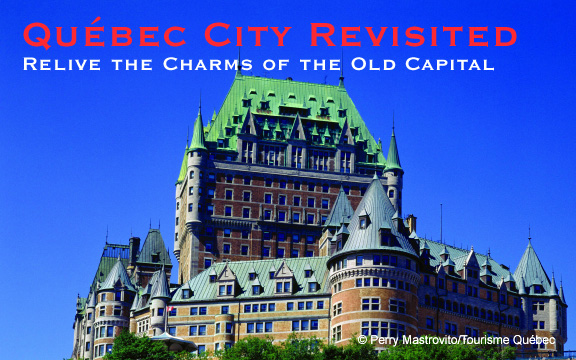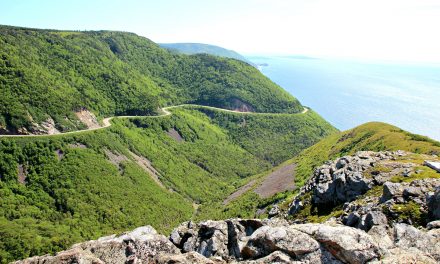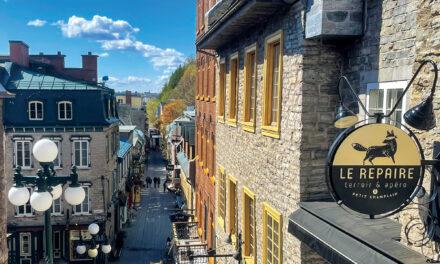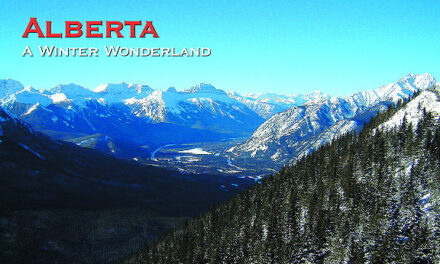Québec City Revisited
Relive the Charms of The Old Capital
Published in the July-August, 2004 Issue of Canadian World Traveller
Text: Excepts from Fabulous Québec Ulysses Travel Guide
Photos: Courtesy of Tourisme Québec www.bonjourquebec.com
A magical place whatever the season, Québec City stands out as much for the stunning richness of its architectural heritage as for the beauty of its location. The Haute-Ville quarter covers a promontory more than 98m high, known as Cap Diamant, and juts out over the St. Lawrence River, which narrows here to a mere 1km. In fact, it is this narrowing of the river that gave the city its name: in Algonquian, kebec means “place where the river narrows”.
Affording an impregnable vantage point, the heights of Cap Diamant dominate the river and the surrounding countryside. From the inception of New France, this rocky peak played a strategic role and was the site of major fortifications early on. Dubbed the “Gibraltar of North America,” today Québec is the only walled city north of Mexico.
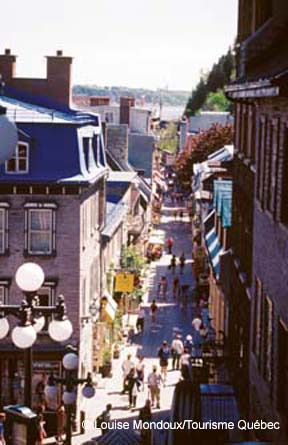
Cradle of New France
Québec City’s atmosphere and architecture are more reminiscent of Europe than of America. The stone houses that flank its narrow streets and the many spires of its churches and religious institutions evoke the France of old. In addition, the old fortifications of the Haute-Ville, the Parliament and the grandiose administrative buildings attest eloquently to the importance of Québec City in the history of the country.
Indeed, its historical and architectural richness is such that the city and its historic surroundings were recognized by UNESCO in 1985 as a World Heritage Site, the first in North America.
Vieux-Québec (Haute-Ville)
As the administrative and institutional centre, the upper part of Old Québec is adorned with convents, chapels and public buildings the construction of which date back, in some cases, to the 17th century.
The walls of Haute-Ville, dominated by the citadel, surround this section of Vieux-Québec and give it the characteristic look of a fortress. These same walls long contained the development of the town, resulting in a densely built bourgeois and aristocratic milieu.
With time, the picturesque urban planning of the 19th century contributed to the present-day image of Québec City through the construction of such fantastical buildings as the Château Frontenac and the creation of public spaces like Terrasse Dufferin, spirit of the Belle Époque.
The Citadelle
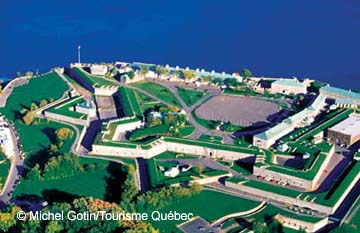 The Citadelle represents three centuries of North American military history and is still in use. Since 1920, it has housed the Royal 22nd Regiment of the Canadian Army, a regiment distinguished for its bravery during World War II.
The Citadelle represents three centuries of North American military history and is still in use. Since 1920, it has housed the Royal 22nd Regiment of the Canadian Army, a regiment distinguished for its bravery during World War II.
Within the circumference of the enclosure are some 25 buildings including the officers’ mess, the hospital, the prison, and the official residence of the Governor General of Canada, as well as the first observatory in Canada.
Château Frontenac
In 1890, the Canadian Pacific Railway company, under Cornelius Van Horne, decided to create a chain of distinguished hotels across Canada. The first of these hotels was the Château Frontenac, named in honour of one of the best-known governors of New France, Louis de Buade, Comte de Frontenac (1622-1698).
Terrasse Dufferin
Walking along the wooden planks of Terrasse Dufferin, overlooking the St. Lawrence, provides an interesting sensation compared to the pavement most of us are used to. It was built in 1879 at the request of the governor general of the time, Lord Dufferin. The boardwalk’s open-air pavilions and ornate street-lamps were designed by Charles Bailliargé and were inspired by the style of French urban architecture common under Napoleon III.
Historic Religious Edifices
The Ursulines arrived in Québec in 1639 and, in 1641, founded a monastery and convent where generations of young girls have received a good education. The Monastère des Ursulines, or Ursuline convent, is the longest-operating girls’ school in North America.
The history of Québec City’s cathedral, the Basilique-Cathédrale Notre-Dame-de-Québec, underscores the problems faced by builders in New France and the determination of Quebecers in the face of the worst circumstances. The cathedral as it exists today is the result of numerous phases of construction and a number of tragedies that left the church in ruins on two occasions.
The Séminaire de Québec was founded in 1663 by Monseigneur François de Laval on orders from the Séminaire des Missions Étrangères de Paris (Seminary of Foreign Missions). Headquarters for the clergy throughout the colony, the seminary was where future priests studied, parochial funds were administered and ministerial appointments were made.
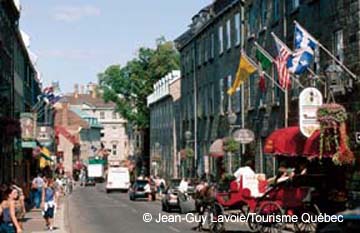
Vieux-Québec (Basse-Ville)
Québec’s port and commercial area is a narrow U-shaped piece of land wedged near the waters of the St. Lawrence. This area is sometimes called the Basse-Ville of Vieux-Québec because of its location just at the foot of the Cap Diamant escarpment.
The cradle of New France, Place-Royale is where, in 1608, Samuel de Champlain (1567-1635) founded the settlement he called “Abitation,” which would become Québec City. In the summer of 1759, three-quarters of the city was badly damaged by British bombardment.
Place-Royale
Place-Royale is the most European quarter of any city in North America. It resembles a village in northwestern France. Place-Royale is laden with symbolism, as it was on this very spot that New France was founded in 1608. After many unsuccessful attempts, this became the official departure point for French exploits in America.
Musée de la Civilisation
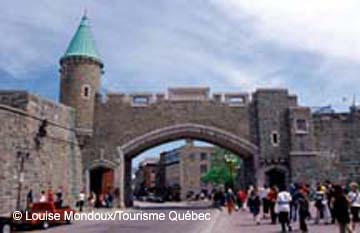 The Musée de la Civilisation is housed in a building that was completed in 1988 in the traditional architectural style of Québec City, with its stylized roof, dormer windows and a bell tower like those common to the area.
The Musée de la Civilisation is housed in a building that was completed in 1988 in the traditional architectural style of Québec City, with its stylized roof, dormer windows and a bell tower like those common to the area.
Architect Moshe Safdie, who also designed the revolutionary Habitat ’67 in Montréal, Ottawa’s National Gallery and Vancouver’s Public Library, designed a sculptural building with a monumental outdoor staircase at its centre.
Grande Allée
Grande Allée appears on 17th-century maps, but it was not built up until the first half of the 19th century, when the city grew beyond its walls. The Grande Allée was originally a country road linking the town to the Chemin du Roi and thereby to Montréal. At that time, it was bordered by the large agricultural properties of the nobility and clergy of the French regime.
Plains of Abraham
Parc des Champs-de-Bataille, commonly known as the Plaines d’Abraham or Plains of Abraham, is where the battle of Québec took place in 1759. The park was created in 1908 to commemorate the event. Extending right up to the cliff overlooking the river, it offers Québec City residents and visitors a superb spot to enjoy all kinds of recreational activities.
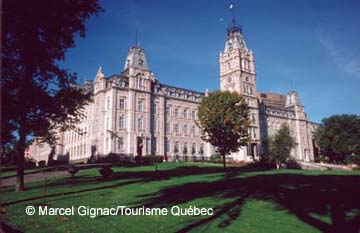 National Assembly
National Assembly
The Hôtel du Parlement is known to Quebecers as l’Assemblée Nationale, the National Assembly. The seat of the government of Québec, this imposing building was erected between 1877 and 1886. It has a lavish French Renaissance Revival exterior intended to reflect the unique cultural status of Québec in the North American context.
Faubourg Saint-Jean-Baptiste
A hangout for young people, complete with bars, cafés and boutiques, the Saint-Jean-Baptiste quarter is perched on a hillside between Haute-Ville and Basse-Ville. The abundance of pitched and mansard roofs is reminiscent of parts of the old city, but the orthogonal layout of the streets is quintessentially North American.
Fabulous Québec
This article consists of excerpts from the excellent travel guide book “Fabulous Québec” published by Ulysses Guide Books and available in the travel sections of many Montreal Region book stores. For more information about this and other travel guide books, visit www.ulyssesguides.com.
For More Info:
Tourisme Québec (Mailing Address)
1255, rue Peel
Montréal, QC H3B 4V4
Toll-Free: 1-877-266-5687
Fax: (514) 864-3188
E-mail: info@bonjourquebec.com
www.bonjourquebec.com
Tourisme Québec
Infotouriste Walk-In Centre
1001, Dorchester Square,
(corner Peel and Ste-Catherine Streets)
Montréal, QC H3B 4V4
Tel.: (514) 873-2015
E-mail: info@bonjourquebec.com
www.bonjourquebec.com
Ulysses Travel Guides
4176, rue St-Denis,
Montréal, QC H2W 2M5
Tel.: (514) 843-9447 (Michael)
E-mail: st-denis@ulysse.ca
www.ulyssesguides.com
Air Canada
Air Canada Centre, PO Box 14000
7373, boul de la Cote-Vertu, Bldg 2
Saint-Laurent, QC H4Y 1H4
Tel.: (514) 847-1106
Toll-Free: 1-888-247-2262
E-mail: See Website
www.aircanada.com
Pascan Aviation (Regional Air Carrier)
222, 2e Avenue,
Aéroport Jean-Lesage International,
Sainte-Foy, QC G2G 2T2
Tel.: (418) 877-8777
Toll-Free: 1-888-313-8777
Fax: (418) 877-8781
E-mail: pascan@pascan.com
www.pascan.com

